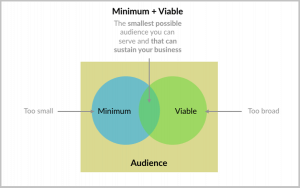In this article, I will guide you through five effective strategies to build a minimum viable audience for your small business. Understanding the concept of a minimum viable audience and its importance is crucial for the success of your lean startup or small business. By implementing these strategies, you can attract and engage your target audience, receive valuable feedback, and ensure the growth of your business.
Key Takeaways:
- A minimum viable audience is the smallest potential market you need to serve to sustain your business.
- Study the needs and preferences of your audience to tailor your product or service effectively.
- Continuously gather feedback from your audience and use it to improve your product or service.
- Offer additional value to your audience to differentiate yourself and foster customer loyalty.
- Treat each product launch with equal importance and learn from previous experiences.
- Understanding your customers and continuously improving your offerings will pave the way for success in your business endeavors.
The Importance of Building a Minimum Viable Audience for Business Success
Everyone here must have heard about businesses that started as small startups with humble beginnings.
Reading about such stories ignites a fire within us to get on our feet and shoot for the stars.
Everything seems to be going smoothly without any hiccups until you realize you need a minimum viable audience.
And this problem is more than just a hiccup.
Doing market research and coming up with more or less of a viable product will mean almost nothing if you do not have the attention of your target audience, along with a minimum market interested in your product, from the get-go.
If you want your business plan to be a hit, you need to build a minimum viable audience.
Reaching critical mass and working with just that can no longer ensure the success of your dreams.
Today, we shall go through five best ways to build a minimum viable audience so that your visions can come to life!
What is a Minimum Viable Audience?
You must have noticed by now that I used the term “minimum viable audience” multiple times.
So what does this mean actually?
And why is it so important for a lean startup or any small business?
Minimum Viable Audience is, as the name suggests, the smallest potential market that you must lock or serve to maintain your business plan and make sure it survives.
It is the minimum number of people you have to serve for the sustenance of your work or business.
Seth Godin’s view casts off a bright light on the importance of focusing on your minimum viable audience.
According to Seth’s Blog, it is best to study the needs of your audience and develop an excellent product instead of creating an average product for the mass.
“Don’t find customers for your products, find products for your customers.” – Seth Godin
If you can thrill and captivate your minimum viable audience by giving them the product they want and need, you will observe that this group is not so small after all.
You will also learn that even if it is just a small group of people, satisfied customers will share their stories (your product or service) with other people, and you can build your market in no time.
Another excellent saying by Seth regarding why you should not focus on the needs of a mass audience is: “don’t try to make a product for everybody, because that is a product for nobody.”
If you are too worried about what everyone wants and try to deliver all these wants into your product, you may end up with a product that nobody wants.
5 strategies on how to build a minimum viable audience
So, now that everyone has an idea about what we mean by the minimum viable audience and why it is so crucial in a world of lean digital marketing and small businesses, it is time to dive into how you can build it up:
-
Study the needs and likes of your audience
This point might seem rather obvious, but it is an essential part of any business venture. Most enterprises do not start big. Building a brand identity and a spot in the market takes time.
An excellent example of how important it is to study the preferences and wants of one’s audience is Clay Collins’ 8-figure software business, which came into being from a simple blog.
Now he is the co-founder and CEO of Leadpages that serves over 46,000 customers.
What Clay Collins noticed from the readers of his blog (his audience) was that offering them visual tips on how to deploy different marketing strategies did much better than 4000-word blogs.
He realized that his audience wanted split test data and examples of putting these strategies into action in real-life businesses.
Making these videos was much more effective in educating his audience and helping them.
Adding to this plus point, making such videos was much more efficient than spending hours on end writing blog posts.
-
Take in all this feedback, whether positive or negative, and improve your product
Even after you launch a new product into the market tailored according to your audience’s preferences, they will likely have something to say about it.
Take in all this feedback, whether positive or negative, and improve your product.
For example, you introduce an application that can keep track of your daily physical activities, like walking and running.
Many people will be satisfied with what it does, but some may say that it cannot check their heartbeat, or that it does not tell them how many calories they burn in a day.
All of these are opportunities for you to improve your product. Take in all the positive feedback and try to enhance them.
On the other hand, lay out all the limitations that your product has and try to add the missing features.
This way, you will keep improving your product and learn to satisfy more people one step at a time.
-
Do not hold back with what you can offer.
If there is an extra or added value that you can offer to your minimum viable audience, do not stop yourself from giving it.
Yes, it might seem like this point will hurt your business on paper. But in the long run, you will realize that your audience appreciates the valuable content and services that you provide.
Suppose you have a software that can record names and numbers and do simple calculations using the data you put in, with a single click.
It would help if you considered giving out the part where you can record names and numbers for free. And put a price on the ability to make simple calculations.
Of course, many people will use it only to record the names and numbers. But they will realize that these numbers usually need to go through figuring and computation to provide valuable information.
With the effortless solution of the other part of your software, the same free users will be willing to pay for the service.
-
Add in some unique calls to action.
There are over 1.5 billion websites in the world, according to internetlivestats.com.
Out of these 1.5 billion websites, there are around 600 million blogs on varying topics.
The last thing you want is to blend in with the other 1.5 billion websites and 600 million blogs.
Many websites and blogs ask their readers and visitors to subscribe to their email or content by blatantly saying, “please subscribe” in one corner of their page.
However, it is highly unlikely that even 0.5% of your page’s visitors will subscribe.
What you need to do to keep these visitors locked is by providing them opportunities to become a part of your audience. It is not just a subscription that will help you survive in the long run.
The blogs on leadpages.net, for example, come with an upgrade that people can download.
This upgrade consists of topics relevant to the main blog, like a pack of articles explaining each point of the original blog post in detail.
-
Treat each product launch equally.
By this point, you must give equal importance to every product as if it were your first launch.
You have to do everything you did, from market research to the product idea, with your second launch, as you did with the first.
See what worked about the last post or product, and what did not go so well with it.
Keep these points in mind and try to remember them in your next launch. It might seem tedious to keep going through the same process over and over again, but it will help you reach for the stars you aimed at.
Is automation necessary?
Do you need to step up your game?
Ask these types of questions before every launch.
“Ambiguity is your friend if you’re looking to innovate”- Brian Clark.
Key Takeaways
The first thing to keep in mind is to understand the needs of your customer and audience.
You are not making a customer for your product. You are making a product for your customer. Always try to improve your product or service by listening to your customers.
What they like and what they do not like will serve as an excellent blueprint for improvement and further development.
Find out how much you can give to your customers without hurting your business.
If you can offer more than what you are offering right now, learn about the options, and draw a line where necessary.
Set yourself apart from other websites and blogs by adding multiple and unique calls to action.
Finally, if you want all your plans to be a success, the least and most you can do is treat every product as a launch and get as much feedback as possible.
Conclusion
You can teach yourself digital marketing with the help of the internet anytime, anywhere.
Is there anything you like or do not like about this post?
Feel free to take part in the discussion from the comments.
You can also share the problems you are facing as a small business and get the required help.
FAQs – Building a Minimum Viable Audience
Q: What is a minimum viable audience?
A: A minimum viable audience refers to the smallest potential market that a business needs to serve in order to sustain its operations and ensure its survival.
Q: Why is a minimum viable audience important for a lean startup or small business?
A: Building a minimum viable audience is crucial for lean startups or small businesses because it allows them to focus their efforts on a specific target audience, understand their needs, and develop products or services that truly meet their requirements. By serving this minimum viable audience effectively, businesses can grow and expand their market in the long run.
Q: How can I study the needs and likes of my audience?
A: To understand the preferences and wants of your audience, conduct market research, engage with your target audience through surveys or interviews, analyze customer feedback, and observe their behaviors and interactions with your products or services. This information will help you tailor your offerings to better meet their needs.
Q: Should I listen to customer feedback and make improvements to my product or service?
A: Yes, customer feedback is invaluable for improving your offerings. Actively listen to both positive and negative feedback, identify areas for improvement, and make necessary adjustments to enhance your product or service based on customer input. Continuous improvement based on customer feedback is essential for building a loyal customer base and attracting new customers.
Q: Can I offer additional value to my minimum viable audience?
A: Yes, offering additional value beyond your core product or service can help differentiate your business and attract and retain customers. Identify opportunities to provide extra features, resources, or content that align with your audience’s needs and interests. This added value can help build trust, loyalty, and a strong relationship with your audience.
Q: How can I set myself apart from other websites and blogs when building my audience?
A: Differentiate yourself by incorporating unique calls to action that go beyond a simple subscription request. Offer downloadable resources, exclusive content, or special promotions that provide value to your audience. By providing distinct and compelling opportunities for engagement, you can stand out from the vast number of websites and blogs and capture the attention and interest of your target audience.
Q: Is it necessary to treat each product launch equally?
A: Yes, it is essential to give equal importance and attention to each product launch, regardless of whether it is your first or subsequent launch. Learn from previous launches, evaluate what worked well and what didn’t, and apply those insights to future launches. Treating each launch with the same level of care and effort helps maintain consistency and enables you to continually refine and improve your offerings.
Q: Is automation necessary for building a minimum viable audience?
A: Automation can be beneficial in streamlining processes and optimizing efficiency, but it is not a requirement for building a minimum viable audience. Focus on understanding your audience, delivering value, and continuously improving your products or services. Automation can be implemented as your business grows and there is a need to scale your operations.
Q: How important is gathering feedback before every launch?
A: Gathering feedback before every launch is crucial for understanding your audience’s needs, validating your product or service, and identifying areas for improvement. By soliciting feedback, you can gain valuable insights, make necessary adjustments, and ensure that your launch aligns with the expectations and preferences of your target audience.







